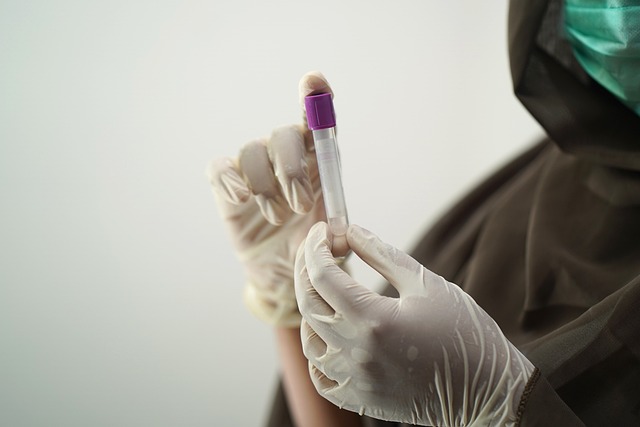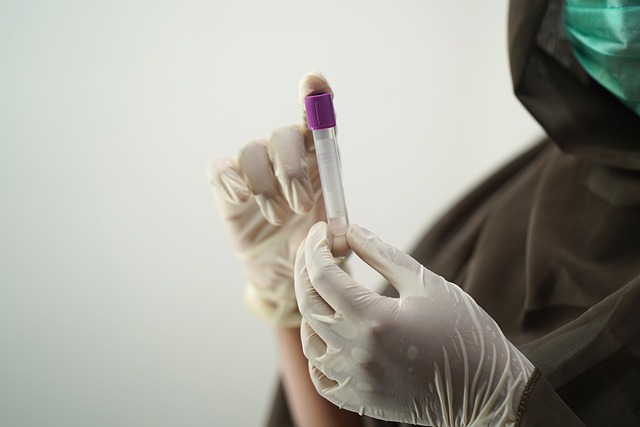The Standard Thyroid Blood Test UK is a critical diagnostic tool for iron deficiency anemia, commonly found in the UK population. This comprehensive test measures iron levels, ferritin, transferrin saturation, and other indicators like haemoglobin and MCV to accurately assess anemia and thyroid function. Its inclusion in routine healthcare screening is vital for early diagnosis and effective treatment intervention, leading to better health outcomes and quality of life. The test's ability to differentiate between iron deficiency anemia and thyroid disorders is particularly important due to overlapping symptoms. It includes the measurement of TSH, Free T4, and sometimes Free T3 to evaluate thyroid health. As a part of the National Health Service (NHS) screening, this test ensures that both iron status and thyroid function are considered, providing healthcare providers with a holistic view necessary for informed medical decisions. Regular use of the Standard Thyroid Blood Test UK is advocated as an effective method for preventing the complications of undiagnosed anemia and thyroid disorders.
Identifying iron deficiency anemia is a critical aspect of health maintenance, and in the UK, blood tests play a pivotal role in this process. This article delves into the nuances of detecting iron deficiency anemia through these tests, emphasizing the significance of the Standard Thyroid Blood Test UK in uncovering underlying iron-related issues. We will explore how medical professionals interpret blood test results to accurately diagnose and manage iron deficiency anemia, ensuring patients receive the care they need for optimal health outcomes. Understanding the diagnostic process is key to early intervention and treatment, which can significantly improve quality of life for those affected.
- Understanding Iron Deficiency Anemia and Its Diagnosis through Blood Tests in the UK
- The Role of Standard Thyroid Blood Test UK in Identifying Iron Deficiency Anemia
- Interpreting Blood Test Results for Iron Deficiency Anemia: What Do Your Numbers Say?
Understanding Iron Deficiency Anemia and Its Diagnosis through Blood Tests in the UK

Iron deficiency anemia is a prevalent condition characterized by an insufficient quantity of haemoglobin, a protein in red blood cells that carries oxygen throughout the body. This health issue arises when the body lacks adequate iron, which is necessary for the production of haemoglobin. In the UK, understanding the root cause of anemia and its implications is crucial for effective management and treatment. The diagnosis of iron deficiency anemia often begins with a blood test, a non-invasive procedure that has become a standard medical investigation.
The Standard Thyroid Blood Test UK plays a pivotal role in the initial stages of diagnosing iron deficiency anemia. This comprehensive panel measures levels of thyroid-stimulating hormone (TSH), thyroxine (T4), and triiodothyronine (T3). While primarily used to assess thyroid function, it also indirectly aids in identifying iron-related disorders by providing insights into the overall health of the body. The test detects iron deficiency by analyzing the concentration of iron, ferritin, and transferrin saturation in the blood. Additional markers such as haemoglobin, mean corpuscular volume (MCV), and red cell count are also assessed to confirm the presence of anemia. Early detection through these blood tests enables healthcare providers to implement targeted treatments promptly, which can significantly improve patient outcomes and overall well-being.
The Role of Standard Thyroid Blood Test UK in Identifying Iron Deficiency Anemia

The Standard Thyroid Blood Test UK plays a pivotal role in the early detection and management of iron deficiency anemia. This comprehensive test panel includes measurements of thyroid-stimulating hormone (TSH), Free T4, and sometimes Free T3 levels, which are critical for assessing thyroid function. Iron deficiency anemia can manifest with symptoms that may mimic those of thyroid dysfunction, making the Standard Thyroid Blood Test UK particularly valuable in differentiating between the two conditions. The test’s ability to measure iron levels alongside other parameters such as ferritin and transferrin saturation is crucial for a precise diagnosis. Early identification through this test allows for timely intervention, which is key to preventing the progression of anemia and mitigating its associated health risks.
In the UK, the Standard Thyroid Blood Test UK is readily available and forms part of routine healthcare screening, especially for those at higher risk of iron deficiency anemia. It is a non-invasive procedure that yields reliable results, enabling healthcare providers to tailor treatment plans effectively. The test’s inclusion of thyroid function markers also ensures that any underlying thyroid issues are not overlooked, which can sometimes present with similar symptoms as iron deficiency anemia. This multifaceted approach to blood testing is instrumental in providing a comprehensive view of an individual’s health status regarding both iron levels and thyroid function, thereby facilitating informed medical decisions.
Interpreting Blood Test Results for Iron Deficiency Anemia: What Do Your Numbers Say?

When interpreting blood test results for iron deficiency anemia, several key indicators are examined to determine if an individual is experiencing this condition. One of the primary markers assessed during a Standard Thyroid Blood Test UK is ferritin, which reflects the body’s stored iron levels. A low ferritin level is often indicative of iron deficiency. Additionally, serum iron and transferrin saturation are evaluated to understand how well the body is absorbing and utilizing iron. These tests can help identify iron deficiency anemia by revealing whether iron stores are depleted. The hemoglobin and hematocrit levels are also crucial; low values suggest that the blood has fewer red blood cells than normal, which is a hallmark of anemia. In the UK, the National Health Service (NHS) offers comprehensive thyroid tests that include these measurements, providing a thorough analysis of one’s iron status. It’s important for healthcare providers to consider these results in conjunction with clinical symptoms and patient history to accurately diagnose iron deficiency anemia. Early detection through regular screening using a Standard Thyroid Blood Test UK can lead to timely intervention, thereby preventing the progression of anemia and its associated health complications.
In conclusion, iron deficiency anemia is a common condition that can be accurately detected through blood tests, a routine diagnostic tool widely available in the UK. The Standard Thyroid Blood Test UK plays a pivotal role in this process by assessing key indicators such as ferritin, haemoglobin, and serum iron levels. Understanding the interpretation of these test results is essential for early diagnosis and effective management of anemia. By familiarising oneself with what the numbers reveal, individuals can take proactive steps towards their health and well-being. The reliability and accessibility of blood tests make them a cornerstone in diagnosing iron deficiency anemia, ensuring patients receive timely treatment and support.
